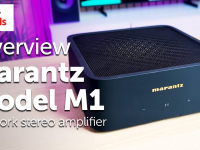
Brand loyalty can be a hugely influential factor for most of us when we’re weighing up a new purchase, particularly with electrical equipment. Goodwill (or a lack of!) built up by previous purchases from a particular brand can help to shape our decision one way or another, and is something that companies rely on to keep us, the consumer, coming back for more. DISCLAIMER: when it comes to brand loyalty, I’m kind of a Sony guy!
That’s not to say that I’ll blindly buy anything the Japanese giant puts out, but from the phenomenally successful Playstation series (owned all of them, including handhelds), to TVs, mobile phones and headphones, I’ve always found their approach to industrial design, easy to use interfaces and use of cutting-edge technology to be right up my street.
Nowhere are all three of these values more readily apparent than in Sony’s latest headphone release, the MDR-1000X. A Bluetooth-enabled, active noise-cancelling touting pair of jaw droppers, the MDR-1000X have been lavished with praise from all quarters, with What Hi-Fi bestowing a 2016 Product of the Year award and an obvious full 5-stars in their review. Having owned a fair few pairs of Sony headphones myself, I was more than happy to throw my name into the hat for our own review, and to see if they really were worthy of all the plaudits.
Starting with the industrial design, an area that Sony almost always nails regardless of anything else that may be right or wrong with a product, it’s pretty clear (to these eyes at least!) that they were onto an absolute winner. Based around a design that they’ve used previously on their over-ear models, the MDR-1000X are a sleek, minimalist headphone that put the showy, sometimes garish nature of other headphone designs to shame. The solid black colour scheme is perfect for those who just want good sound, not to be a walking billboard or fashion statement – which ironically makes it a fashion statement in its own right, but one that almost anybody could live with.

“The noise-cancelling function is excellent and the sound quality superb. Wrap it all up in an appealing and innovative package and you’ve got a serious contender for best-in-class.” What Hi-Fi Sound & Vision Award Winner 2016.
The cups fit wonderfully over the ear, and the frame and housing are the right side of compact feeling, sturdy and well built, but not cumbersome and overly heavy. Made from synthetic leather rather than the real stuff (which I’ve absolutely no problem with at all), the pads never felt uncomfortable or got too hot or sweaty. Their portability was obviously a plus point, given that the wireless nature, not to mention the active noise-cancelling, means they’ll primarily be used on the go. Folding in on themselves, the Sonys are as easy to keep tucked safely away as any competitor in the category.
Connecting up to my phone (a Samsung Galaxy S7) was easy, connecting up after pressing down a button on the underside of one of the cups. Rather than getting stuck straight into ‘proper’ listening, I decided to have a play with some of the Sony’s nifty features. As soon as the set is placed on the head the noise cancellation kicks in, and this worked a treat even just as a means of isolating the listener from the general hustle and bustle, even without music playing. Touching your hand to the back of the right hand cup whilst wearing reveals one of the 1000X’s smartest features, pausing the music and reducing the noise cancellation, allowing you to listen to the outside world or people talking to you without having to remove the headphone at all. It certainly made conversations look a little odd, but the execution was flawless, taking one more minor annoyance out of the routine of the daily headphone user.
Sony’s ‘Ambient Sound’ modes are definitely also worthy of a mention. Touching the button marked with the aforementioned title gives the user two tweaked modes of isolation, ‘Voice mode’ and ‘Normal mode’. Full-on noise cancellation can be somewhat disconcerting for those not used to it, particularly commuters who won’t necessarily want to miss out on everything that might be happening around them. Need to hear what time the next train or bus is arriving? Switch to Voice mode and you’ll be able to listen for important announcements without missing out on your favourite songs. Likewise, if a listener finds themselves in a busy area and needs to keep an ear out for traffic, Normal mode allows everyday sounds to filter through whilst still making your music clearer and better defined than a standard pair of cans. Both modes are definitely worthwhile inclusions, being both practical and easy to switch between in a hurry.
On to the listening and it’s fair to say that the Sonys definitely continued to impress. Playing the new Fleet Foxes track, Third of May / Odaigahara, showed the Sony ease when dealing with a densely produced song. The vocals of Robin Pecknold had their usual earthy tone; the band’s trademark guitar-driven, harmony-wielding sound was full and rich throughout the track’s near 9-minute run time. Similarly, Little Dragon’s newest single, High, doesn’t stray too far from their own signature sound. The bass-driven electronica here is the perfect accompaniment to the gorgeous vocals of lead singer, Yukimi Nagano. Nagano’s voice sounded full-bodied, with little trace of sibilance and nicely complimented the weighty bottom end of the track.
The MDR-1000X definitely leans towards a weighty, mid-range and lower end richness, giving a real solidity to songs, but with a top end that is still capable of showing the delicate nuances of the singer’s vocals – a much admired trait. The fact that the products extensive list of positives doesn’t overshadow the fantastic sound quality on offer, is very much to Sony’s credit. Fanboy or not, these are headphones that have to be top of anybody’s audition list!
Shop for Headphones with Richer Sounds.
Author: Chris, Liverpool store






I personally like the design. They look smooth and professional. Their noise cancelling technologies look also super cool. Thanks